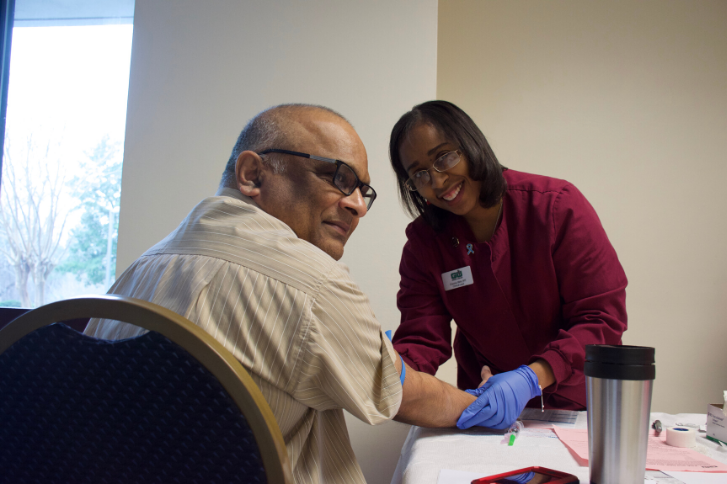Should I Get Screened for Prostate Cancer? A Look at the Evidence
Updated for Prostate Cancer Awareness Month, September 2024!
Prostate-specific antigen (PSA) is an enzyme secreted by the prostate gland, a small walnut-shaped organ surrounding the urethra in the lower urinary tract. PSA is produced in small amounts in the blood of men with healthy prostates, but an elevated PSA may signal the presence of prostate cancer.
PSA screening for prostate cancer was done routinely for years but has become a heavily debated subject. Currently, the United States Preventive Services Task Force (USPSTF), a volunteer panel of experts in general disease prevention, has given PSA screening a Grade C for men ages 55 to 69. This means there is moderate certainty in a small net benefit to screening, and physicians should selectively offer PSA screening to patients based on professional judgment and preference.
The American Urological Association (AUA), an organization of experts in urological diseases, recommends that men aged 55 to 69 undergo shared decision-making with their physician and that the most significant benefit to screening is in this age group. As the decision to undergo screening strongly involves patient preference, an understanding of the evidence supporting PSA screening is crucial.
It is worth noting that the United States Preventive Services Task Force (USPSTF) is updating its screening recommendations, and we should see new guidelines within the next several months.
Georgia Urology’s Recommendations for Screening
- If you are 50-69 with low prostate cancer risk
- If you are 45-69 with higher risk, including being an African American or Caribbean man, or if your close relatives, and especially your brother, have had prostate cancer
- If you are 40-69 with high risk, including multiple close family members that have been diagnosed with prostate cancer before the age of 65, and if you have had cancer previously.
- If you have gene mutations that can predispose you to prostate cancer (e.g., BRCA1 or BRCA2)
- If you have a high PSA or a PSA trending upward
- If you have any other symptoms of prostate cancer
Men over 70 are not recommended for prostate cancer screening.
A Brief History of PSA
PSA was first discovered in the 1970s and was approved in the 1980s by the FDA to monitor prostate cancer recurrence. In 1991, Catalona et al. published a seminal paper in the New England Journal of Medicine showing that PSA was a good predictor of a prostate cancer diagnosis.[1] PSA soon became a widely used screening test throughout the United States for asymptomatic men. An arbitrary cut-off of PSA of around four was developed to guide prostate biopsies. Then, virtually all prostate cancers found via biopsy were treated with radiation and/or prostatectomy. We now know this was an overreaction that led to overtreatment.
Following this, as one would expect, the incidence of prostate cancer skyrocketed.
Before routine PSA testing, 1 in 10 men were diagnosed with prostate cancer. After widespread PSA testing, 1 in 6 men were diagnosed with prostate cancer. Corresponding to this, in the mid-90s, mortality due to prostate cancer began to decline at a rate of approximately 4% per year. This may have been due to an increase in PSA screening; however, some have suggested it is due to earlier and increasingly aggressive prostate cancer treatments beginning around the same time.
PSA and Evidence from the Screening Trials
Eventually, several randomized control trials were performed to determine if screening for prostate cancer using PSA conferred a prostate cancer survival benefit. Perhaps the two best-designed studies were the Prostate, Lung, Colorectal, and Ovarian Screening Trial (PLCO) and the European Randomized Study of Screening for Prostate Cancer (ERSPC), summarized below. [2,3]
| PLCO | ERSPC | |
| Number of patients | 76,693 | 162,243 |
| Age range | 55-74 | 55-69 |
| PSA interval | Annually for 6 years | Every 2 to 4 years |
| Median follow-up | ~13 years | ~13 years |
| Contamination | ~77% | ~20% |
| Prostate cancer specific mortality Risk Reduction (screen v control) |
1.08 |
0.79 |
In summary, PLCO is an American trial that enrolled men aged 55-74 in a screening or non-screening arm. After ten years of follow-up, there was no improvement in prostate cancer-specific mortality in the screened group. However, this study has been criticized for its high level of contamination. This refers to the fact that a large percentage of men in the non-screening arm (approximately 77%) had a PSA level tested during the study.
PLCO did not compare screening to non-screening; it compared routine screening to opportunistic screening, which is very prevalent in the US.
The ERSPC is a European trial of men aged 55 to 69 randomized to a screened arm that received PSA screening every 2 to 4 years and a non-screening group. The contamination rate was much lower in the ERSPC trial, as routine PSA tests are uncommon throughout Europe. The 13-year update of this study shows that a man’s risk of dying of prostate cancer is 21% less when screened for prostate cancer. 781 men would need to be screened, and 27 cancers would need to be diagnosed to save one life from prostate cancer.[3] Additionally, subsets of the ERSPC study have been followed for 19 years and have shown an even more significant reduction in metastatic disease and cancer-specific mortality in patients who underwent screening [4].
However, there are important negative associations with PSA screening that have been noted in the scientific literature and are summarized in the table below.
| Harm | Estimate | Source |
| False positive | 75.9% | Proportion w PSA >3, negative bx (ERSPC) |
| Overdiagnosis | 66% 23-42% |
Screen detected, 4 year interval (ERSPC) Modelling studies (Heijnsdijk et al 2009) [5] |
| Post-biopsy fever | 4% | Loeb et al 2012 ERSPC [6] |
| Post-biopsy hospitalization | 1% | Loeb et al 2012 ERSPC [6] |
| Hematuria/hematospermia | 20-50% | Post-biopsy (ERSPC) |
| Incontinence/ED | 20-30% | All treatment types (Chou et al 2011, USPSTF meta-analysis) [7] |
| Death | 1-5/1000 | Within 1 month of surgery (Chou et al 2011, USPSTF meta-analysis) [7] |
Possible Prostate Cancer Treatments
Knowing what we do now, there are a wide range of treatments for prostate cancer. Low-grade cancers can often be left alone, and we use watchful waiting or active surveillance to monitor the cancer and ensure it does not spread or get worse. For patients concerned about their low-grade cancer diagnosis and are not candidates for invasive treatment, a procedure known as NanoKnife ablation may be a good option for destroying low-grade cancer tissue.
Higher-grade prostate cancers require more invasive treatment, which may include one or more of the following therapies.
- External beam radiation therapy
- Brachytherapy
- Cryotherapy
- Prostatectomy
Possible therapeutic options for your circumstance and the risks of each will be discussed during a consultation with your urologist.
In Summary
- Professional medical societies recommend discussing PSA screening with your physician and making a shared decision regarding screening. New guidelines are forthcoming.
- A well-performed clinical trial comparing PSA screening and non-screening found a reduction in metastatic disease and death due to prostate cancer for men who underwent PSA screening.
- There are several harms associated with PSA screening, including overtreatment and complications associated with biopsy and surgery. However, better use of the PSA as a trend test rather than using a cut-off has made the PSA a very accurate diagnostic tool.
- We now know more about low versus high grade, allowing us to offer less or non-invasive options to
- Patients should weigh the risks and benefits of PSA screening according to their values and preferences and discuss these with their physicians.
References
- Catalona WJ, Smith DS, Ratliff TL, Dodds KM, Coplen DE, Yuan JJ, Petros JA, Andriole GL. Measurement of prostate-specific antigen in serum as a screening test for prostate cancer. N Engl J Med. 1991 Apr 25;324(17):1156-61. Erratum in: N Engl J Med 1991 Oct 31;325(18):1324.
- Andriole GL, Crawford ED, Grubb RL 3rd, Buys SS, Chia D, Church TR, Fouad MN, Isaacs C, Kvale PA, Reding DJ, Weissfeld JL, Yokochi LA, O’Brien B, Ragard LR, Clapp JD, Rathmell JM, Riley TL, Hsing AW, Izmirlian G, Pinsky PF, Kramer BS, Miller AB, Gohagan JK, Prorok PC; PLCO Project Team. Prostate cancer screening in the randomized Prostate, Lung, Colorectal, and Ovarian Cancer Screening Trial: mortality results after 13 years of follow-up. J Natl Cancer Inst. 2012 Jan 18;104(2):125-32. doi: 10.1093/jnci/djr500. Epub 2012 Jan 6.
- Schröder FH, Hugosson J, Roobol MJ, Tammela TL, Zappa M, Nelen V, Kwiatkowski M, Lujan M, Määttänen L, Lilja H, Denis LJ, Recker F, Paez A, Bangma CH, Carlsson S, Puliti D, Villers A, Rebillard X, Hakama M, Stenman UH, Kujala P, Taari K, Aus G, Huber A, van der Kwast TH, van Schaik RH, de Koning HJ, Moss SM, Auvinen A; for the ERSPC Investigators. Screening and prostate cancer mortality: results of the European Randomised Study of Screening for Prostate Cancer (ERSPC) at 13 years of follow-up. Lancet. 2014 Aug 6. pii: S0140-6736(14)60525-0. doi: 10.1016/S0140-6736(14)60525-0. [Epub ahead of print]
- Osses DF, Remmers S, Schröder FH, van der Kwast T, Roobol MJ. Results of Prostate Cancer Screening in a Unique Cohort at 19yr of Follow-up. Eur Urol. 2019 Mar;75(3):374-377. doi: 10.1016/j.eururo.2018.10.053. Epub 2018 Nov 9.
- Heijnsdijk EA, der Kinderen A, Wever EM, Draisma G, Roobol MJ, de Koning HJ. Overdetection, overtreatment and costs in prostate-specific antigen screening for prostate cancer. Br J Cancer. 2009 Dec 1;101(11):1833-8. doi: 10.1038/sj.bjc.6605422. Epub 2009 Nov 10.
- Loeb S, van den Heuvel S, Zhu X, Bangma CH, Schröder FH, Roobol MJ. Infectious complications and hospital admissions after prostate biopsy in a European randomized trial. Eur Urol. 2012 Jun;61(6):1110-4. doi: 10.1016/j.eururo.2011.12.058. Epub 2012 Jan 5.
- Chou R, Dana T, Bougatsos C, Fu R, Blazina I, Gleitsmann K, Rugge JB. Treatments for Localized Prostate Cancer: Systematic Review to Update the 2002 U.S. Preventive Services Task Force Recommendation [Internet]. Rockville (MD): Agency for Healthcare Research and Quality (US); 2011









